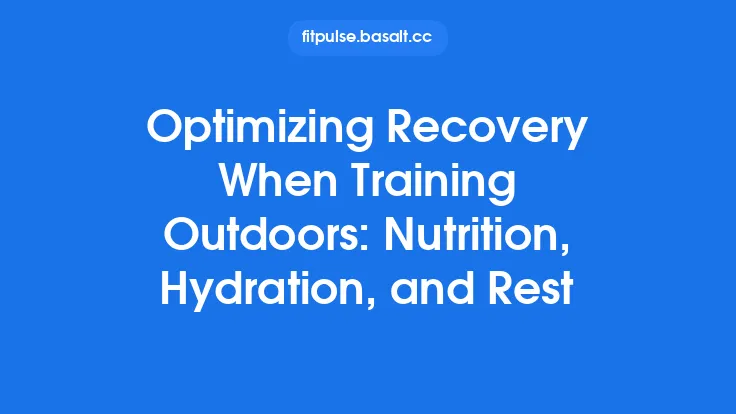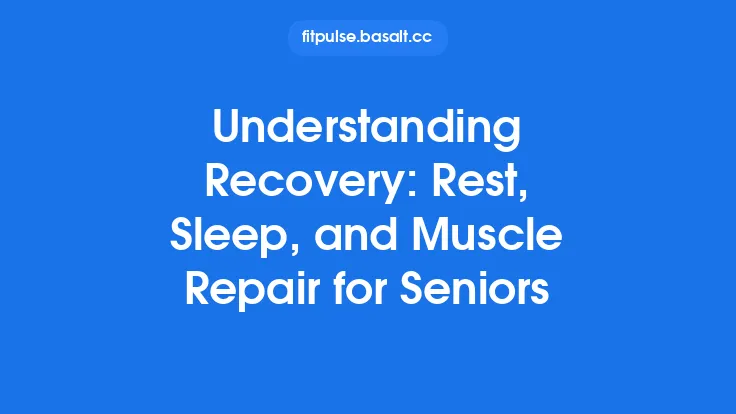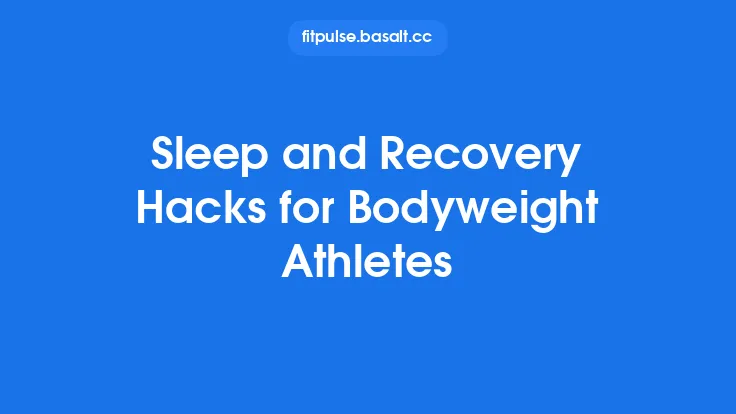Recovery is the cornerstone of any successful cycling program, yet it often receives far less attention than the hours spent on the saddle. While training drives adaptation, it is the quality of the recovery process that determines whether those adaptations become lasting performance gains or simply fatigue that erodes progress. This article dives deep into three pillars that together form a comprehensive recovery protocol for cyclists of all levels: sleep, nutrition, and active‑rest techniques. By understanding the science behind each pillar and learning how to apply practical strategies on a daily basis, you can accelerate muscle repair, replenish energy stores, sharpen mental focus, and ultimately ride stronger, faster, and more consistently.
Sleep Fundamentals for Cyclists
Why Sleep Matters
- Hormonal regulation – Deep sleep triggers the release of growth hormone (GH) and testosterone, both of which are essential for protein synthesis and muscle repair.
- Glycogen restoration – Liver and muscle glycogen stores are replenished most efficiently during the early stages of sleep when insulin sensitivity peaks.
- Neural recovery – REM sleep supports the consolidation of motor learning, helping the brain fine‑tune the neuromuscular patterns you develop on the bike.
- Immune function – Adequate sleep bolsters innate immunity, reducing the risk of infections that can derail training cycles.
How Much Sleep Is Enough?
| Training Load | Recommended Sleep (hours) |
|---|---|
| Light (≤5 h/week) | 7–8 |
| Moderate (5–12 h/week) | 8–9 |
| Heavy (>12 h/week) | 9–10+ (including naps) |
These ranges are guidelines; individual needs can vary based on age, genetics, and lifestyle factors. The key is to consistently meet the lower bound of the range for your current training load.
Optimizing Sleep Quality
- Establish a Consistent Rhythm
- Go to bed and wake up at the same time every day, even on weekends.
- Aim for a pre‑sleep wind‑down period of 30–60 minutes (dim lights, low‑stimulus activities).
- Control Light Exposure
- Morning: Bright natural light within the first hour after waking helps reset the circadian clock.
- Evening: Limit blue‑light exposure from screens; consider amber‑tinted glasses or night‑mode settings after 7 p.m.
- Temperature Management
- Keep the bedroom cool (≈ 16–19 °C or 60–66 °F). A slight drop in core body temperature signals the body to initiate sleep.
- Nutrition Before Bed
- A small protein‑rich snack (e.g., Greek yogurt, cottage cheese, or a whey shake) can supply amino acids throughout the night without causing digestive discomfort.
- Avoid large meals, caffeine, and alcohol within 2–3 hours of bedtime.
- Mind‑Body Techniques
- Progressive muscle relaxation, diaphragmatic breathing, or a brief meditation session can lower sympathetic activity and promote faster sleep onset.
- Track and Adjust
- Use a simple sleep diary or a wearable that records total sleep time, sleep efficiency, and time spent in deep/REM stages. Look for trends rather than day‑to‑day fluctuations.
Nutrition for Recovery
Recovery nutrition is distinct from the fueling strategies used during long rides. The focus is on rebuilding tissue, replenishing depleted stores, and reducing inflammation after the effort has ended.
1. Macronutrient Balance
| Nutrient | Primary Role in Recovery | Recommended Post‑Ride Ratio* |
|---|---|---|
| Protein | Supplies essential amino acids for muscle protein synthesis (MPS). | 0.3–0.4 g · kg⁻¹ body weight (≈ 20–30 g) within 30 min–2 h post‑ride |
| Carbohydrate | Replenishes glycogen, restores insulin sensitivity. | 1.0–1.2 g · kg⁻¹ body weight (≈ 60–80 g) within the same window |
| Fat | Supports hormone production and provides essential fatty acids. | 0.2–0.3 g · kg⁻¹ body weight (≈ 10–15 g) – can be included in the post‑ride meal but keep it moderate to avoid slowing gastric emptying. |
\*The exact ratio can be adjusted based on the intensity and duration of the session. Ultra‑high‑intensity intervals may benefit from a slightly higher protein proportion, while ultra‑endurance rides may require a larger carbohydrate load.
Practical Meal Ideas
- Quick shake: Whey isolate (20 g) + fast‑acting carbs (e.g., maltodextrin, fruit juice) + a teaspoon of flaxseed oil.
- Whole‑food option: Grilled chicken breast, quinoa, roasted sweet potatoes, and a side of mixed vegetables drizzled with olive oil.
- Vegetarian/vegan: Lentil and chickpea salad with brown rice, avocado, and a sprinkle of pumpkin seeds.
2. Micronutrients & Antioxidants
| Micronutrient | Why It Matters for Cyclists | Food Sources |
|---|---|---|
| Vitamin C | Collagen synthesis, antioxidant protection. | Citrus fruits, berries, kiwi. |
| Vitamin E | Membrane stability, reduces oxidative stress. | Almonds, sunflower seeds, spinach. |
| Magnesium | Muscle relaxation, ATP production. | Dark leafy greens, bananas, black beans. |
| Zinc | Immune function, protein synthesis. | Oysters, pumpkin seeds, lean beef. |
| Iron (especially for female cyclists) | Oxygen transport, prevents anemia. | Red meat, lentils, fortified cereals (pair with vitamin C for better absorption). |
| Omega‑3 fatty acids | Anti‑inflammatory, supports joint health. | Fatty fish (salmon, mackerel), chia seeds, walnuts. |
A well‑rounded diet that includes a colorful variety of fruits, vegetables, lean proteins, and whole grains typically supplies these nutrients. For athletes with higher sweat losses or those training at altitude, a targeted supplement (e.g., magnesium glycinate 200–400 mg) may be beneficial after consulting a healthcare professional.
3. Hydration & Electrolyte Replenishment
- Fluid volume: Aim to replace 150 % of the fluid lost during the ride. Weigh yourself pre‑ and post‑ride; each kilogram of body‑weight loss ≈ 1 L of fluid.
- Electrolytes: Sodium, potassium, calcium, and magnesium are lost in sweat. A post‑ride drink containing 300–600 mg sodium and 200–400 mg potassium helps restore balance and improves water retention.
- Timing: Begin rehydration within 30 minutes of finishing, then continue sipping water or low‑calorie electrolyte beverages over the next 2–3 hours.
4. Timing and Frequency
- The “Anabolic Window”: While the classic 30‑minute window is a useful guideline, research shows that the muscle protein synthesis response remains elevated for up to 5 hours post‑exercise if adequate protein is consumed.
- Meal Frequency: For cyclists training multiple times per day, distribute protein intake evenly (≈ 0.3 g · kg⁻¹) across 3–4 meals to maximize MPS.
- Night‑time Nutrition: A protein‑rich snack before bed (e.g., casein or a small portion of cottage cheese) provides a steady supply of amino acids throughout the night, supporting overnight repair.
Active Rest Techniques
Active rest is not “doing nothing”; it is a purposeful, low‑intensity approach that accelerates recovery by promoting blood flow, flushing metabolic waste, and maintaining mobility without adding significant physiological stress.
1. Low‑Intensity Riding (Recovery Spins)
- Duration & Intensity: 30–60 minutes at < 55 % of FTP (Functional Threshold Power) or a heart‑rate zone 1–2.
- Benefits:
- Enhances capillary perfusion, delivering oxygen and nutrients to fatigued muscles.
- Facilitates lactate clearance via the Cori cycle.
- Keeps the neuromuscular system “tuned” without taxing glycogen stores.
- Implementation: Schedule a recovery spin the day after a hard interval session or a long endurance ride. Keep cadence high (90–100 rpm) to encourage smooth pedal stroke mechanics.
2. Mobility & Dynamic Stretching
| Goal | Example Exercise | Reps/Duration |
|---|---|---|
| Hip flexor lengthening | Kneeling hip flexor stretch with a gentle forward lunge | 30 s each side |
| Hamstring flexibility | Standing forward fold with slight knee bend | 30 s |
| Ankle dorsiflexion | Wall ankle mobilization (lean forward, keep heel down) | 10 reps each side |
| Thoracic rotation | Seated thoracic twist with a foam roller | 10 reps each side |
Perform a short (10‑15 minute) mobility routine after each ride, focusing on the hip, knee, and ankle complexes that experience the greatest repetitive loading.
3. Foam Rolling & Myofascial Release
- Target Areas: Quadriceps (especially rectus femoris), IT band, glutes, calves, and lower back.
- Technique: Roll slowly (≈ 1 in/s) over each spot for 30–60 seconds, pausing on tender nodules until the tension eases.
- Frequency: 2–3 sessions per week, preferably after rides or before sleep.
4. Cross‑Modal Low‑Impact Activities
| Activity | Why It Helps Cyclists | Typical Session Length |
|---|---|---|
| Swimming | Full‑body, non‑weight‑bearing cardio; improves lung capacity. | 30–45 min easy laps |
| Yoga (Restorative) | Enhances flexibility, reduces sympathetic tone, improves breathing patterns. | 20–30 min gentle flow |
| Pilates | Core stabilization, spinal alignment, and controlled breathing. | 30 min session |
| Walking/Hiking | Light mechanical loading, promotes circulation without bike‑specific fatigue. | 45–60 min at conversational pace |
These modalities can be incorporated on “active‑recovery days” when you want mental variety while still supporting physiological repair.
5. Compression & Contrast Therapy
- Compression garments (e.g., calf sleeves, full‑leg tights): Wearing them for 1–2 hours post‑ride can reduce perceived muscle soreness by enhancing venous return.
- Contrast showers (alternating hot/cold): A 1‑minute hot phase followed by 30 seconds cold, repeated 3–4 times, may improve vascular perfusion and reduce edema. Use cautiously if you have circulatory issues.
Integrating Recovery into Your Training Plan
Periodic Recovery Weeks
- Structure: Every 3–4 weeks, replace one hard training day with a recovery spin and add an extra rest day or easy ride.
- Purpose: Allows super‑compensation to occur, preventing chronic fatigue and overreaching.
Monitoring Fatigue
| Metric | How to Measure | Action Threshold |
|---|---|---|
| Resting HRV (Heart‑Rate Variability) | Morning HRV via a chest strap or finger sensor | ↓ > 10 % from baseline → consider additional rest |
| Subjective Wellness Score (0‑10) | Quick daily questionnaire (sleep, mood, soreness) | ≤ 5 for 2 consecutive days → schedule a light day |
| Morning Heart Rate | Baseline resting HR after waking | ↑ > 5 bpm from norm → prioritize sleep and hydration |
| Training Load (TSS) | Use your training software to track daily Training Stress Score | Cumulative TSS > 800 over 7 days → insert a recovery day |
Balancing Stress and Recovery
- Plan Recovery First: When designing a macro‑cycle, block out recovery days before you fill in hard sessions.
- Use “Recovery Windows”: After a high‑intensity interval block, schedule 48 hours of low‑intensity work, then a full rest day.
- Adjust on the Fly: If any fatigue metric spikes, replace the next hard session with an active‑rest ride or a complete rest day.
Practical Tools & Tracking
- Sleep Trackers: Devices that record total sleep time, sleep stages, and sleep efficiency (e.g., Oura Ring, WHOOP).
- HRV Apps: EliteHRV, HRV4Training – provide daily readiness scores.
- Nutrition Log: Simple spreadsheet or apps like MyFitnessPal to ensure post‑ride protein and carb targets are met.
- Recovery Questionnaires: The “Recovery-Stress Questionnaire for Athletes” (RESTQ‑Sport) can be completed weekly to capture mental and physical recovery status.
- Bike‑Computer Metrics: Use power‑based “Training Stress Score” (TSS) and “Intensity Factor” (IF) to gauge the load placed on the body and plan appropriate recovery.
Key Takeaways
- Sleep is non‑negotiable. Aim for 8–10 hours on heavy training weeks, prioritize a consistent schedule, and create a sleep‑friendly environment.
- Post‑ride nutrition should be balanced. Combine ~0.3 g · kg⁻¹ protein with ~1 g · kg⁻¹ carbohydrate within the first two hours, and include micronutrients and electrolytes to support tissue repair and fluid balance.
- Active rest is a strategic tool. Low‑intensity spins, mobility work, foam rolling, and cross‑modal activities keep blood flowing, reduce stiffness, and maintain neuromuscular readiness without adding significant fatigue.
- Integrate recovery into the training calendar. Schedule regular recovery weeks, monitor objective (HRV, resting HR) and subjective (wellness scores) markers, and be ready to adapt the plan when fatigue signals rise.
- Use simple tracking tools to make recovery visible and measurable, turning it from an afterthought into a core component of performance development.
By treating sleep, nutrition, and active‑rest techniques as equal partners to your on‑bike training, you create a resilient physiological foundation. This foundation not only speeds up the repair process after hard sessions but also enhances the quality of each subsequent ride, leading to steady, long‑term improvements in power, endurance, and overall cycling enjoyment.





